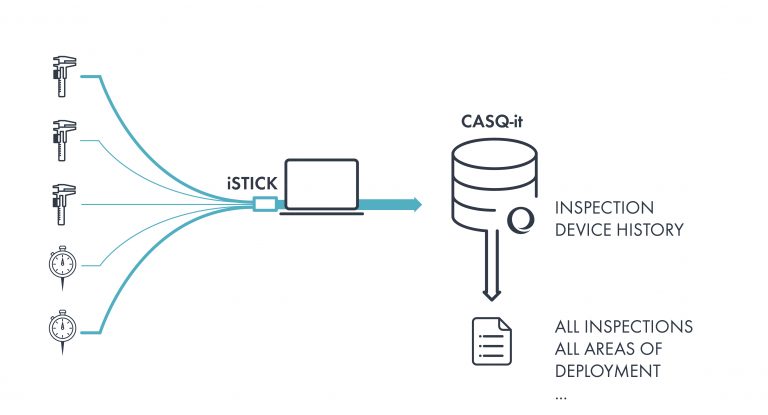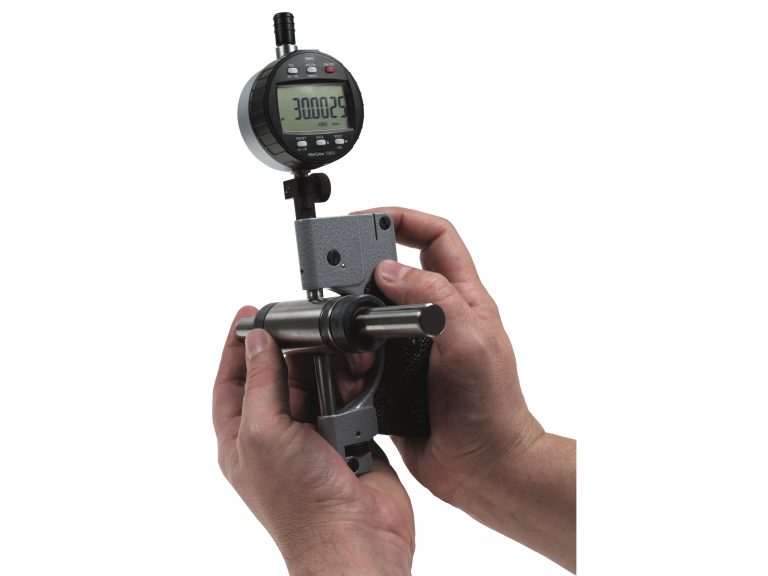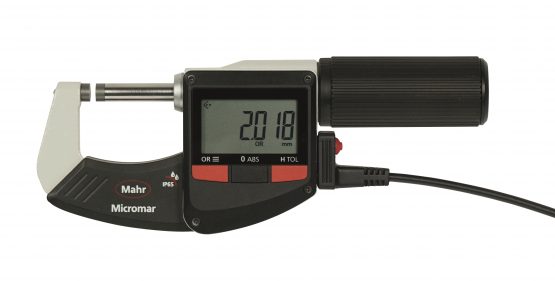Although the respective standards are clear-cut, tracing handheld gauges is still a process where there is a huge gap between theory and practice. What many automated measuring devices do in no time at all is still a major hurdle for those who have to use handheld gauges.
However, this is not the case at Mahr GmbH. This gauge manufacturer worked with us to develop a process in which not only the readings but also the gauge IDs are automatically imported into their quality management software. As a result, these handheld gauges have now also been fully integrated into the Industry 4.0 environment.
Below, Jens Stockburger, Head of Product Management Length at Mahr GmbH, and Jens Leder, our Product Manager for Gauge Management, answer the most important questions that arise on the hard and software side with respect to the traceability of handheld gauges.
1. In the quality management area, a rise in the level of digitization is also now perceptible. However, when it comes to “intelligent networking”, very few people immediately think of the topic of gauges. Why is nobody taking advantage of the opportunity to set up an intelligent, networked data exchange in the gauge management sector?
Leder: In the past, the problem was that handheld gauges were only capable of limited communication – unlike high-tech measuring instruments. It was not possible to pass on any additional data, such as gauge IDs, with the actual readings. We have now been able to close this gap in communications through working with Mahr, our cooperation partner. In a joint development project, we have designed a solution for automatically passing on and processing gauge IDs. Not only is this efficient, but above all it meets a fundamental requirement which is set down in a number of different standards.
2. Which special requirements, both of a conceptual and technical nature, were contemplated at the beginning of the development project with regard to being able to trace handheld measuring instruments?
Stockburger: At the beginning of the project, we were faced with the problem that up until that point in time, only the recorded readings were being passed on to our CAQ system from the handheld measuring instruments – which did not include the gauge IDs. However, these are absolutely essential to ensure that the documented measurement results can be assigned to specific measuring instruments, which, for example, is a major advantage, if testing devices are occasionally used by or rotated through several different workstations or departments. Although in the past the individual readings were documented in these cases, it was, however, impossible to trace which gauges were actually used to do the measurements. This meant that it was not possible to guarantee seamless traceability.
After a fair amount of development work, we have now managed to solve this challenge. All our radio gauges with an integrated wireless interface now transmit their respective gauge IDs when they receive a request from our CAQ software to this effect. These IDs can be simultaneously entered in a test log, thus ensuring that the established readings are one hundred percent transparent. This allows us to comply with the strict requirements set down in the latest industry standards.
The main technical requirement involved in achieving this was to adapt the hardware and firmware of the devices so that they were capable of storing an individual ID and communicating this via their radio interface.

3. What are the standard requirements in this area?
Leder: These explicitly address the issue of traceability and ensuring the validity of previous measurement results as soon as a faulty gauge is discovered. And it is precisely this requirement that is mentioned over and over again in a large number of different standards – from DIN EN ISO 9001, chapter 7.1.5.2, to industry-specific specifications. These include chapter 7.6 of ISO/TS 16949 and the new IATF 16949 standard for the automotive industry, FDA 21 CFR 820 for the medical engineering sector and EN 9100 for the aerospace industry. To date, the requirement to ensure traceability could only be met through an immense organizational effort on the part of the gauge management division as the gauge IDs had to be recorded separately during EVERY SINGLE quality inspection. This is not only prone to errors but also inefficient. Nowadays, this is handled completely automatically – even totally imperceptibly – using intelligent communication solutions, such as that linking Mahr’s handheld gauges with their CASQ-it GMS CAQ software.
4. What other areas of application can you envisage now that data can automatically be read from handheld measuring instruments?
Stockburger: Being able to guarantee undisputed traceability is not only a requirement contained in different standards but actually also simplifies the processes in your own company – for example in the event of a complaint. Your gauge management section also benefits from the fact that your measuring instruments not only transmit their readings but also their unique IDs. Constantly comparing these in your gauge management system, for example, CASQ-it GMS, provides information as to whether the gauges have been released or are possibly blocked as they need to be calibrated. This provides operators with the certainty that only calibrated gauges are used and allows them to stay in control of the process.
The transmission of these IDs also allows the calibration process to be optimized: The measuring instrument can be automatically identified and the appropriate calibration plan called up directly from the CAQ system. Minimizing the manual input and selection processes saves time and reduces the susceptibility to errors.
Last but not least, transmitting the serial number is important when we direct our thoughts towards Industry 4.0. The most important prerequisite to achieving a scenario where production is networked, intelligent and controls itself is that all the participants in the field can be clearly identified. This is the only way of ensuring successful machine-to-machine communication.

Alongside their readings, handheld gauges, such as this digital indicator, also transmit their IDs to your CAQ software (Photo source: Mahr GmbH)
5. What future prospects does the solution offer, especially in view of the advances in digitization?
Leder: There is certainly a lot of potential for further developing the intelligence of such a communication system. In the future, gauges will not only “know” their own IDs but also their calibration plans or next calibration dates and will then notify the employees accordingly when these are due. The further the technological possibilities in the context of digitization and Industry 4.0 progress, the more powerful communications between the gauges and your CAQ software will become.
6. Is the retrieval of the IDs limited to radio gauges or is there also a solution for wired devices?
Stockburger: In 2017, Mahr created a new interface for a new bidirectional USB data cable for its latest generation of outside micrometers. Among other things, it is now possible to send a command to a gauge from a PC with the request to return its serial and article numbers.

Even modern, wired gauges now automatically transmit their data to the CAQ system. (Photo source: Mahr GmbH)
7. Right now, many companies are quite critical in their view of the new buzz topics “Industry 4.0” and “digitization” due to a lack of appropriate standards. Who will have access to intelligent gauge communication – and what prerequisites need to be met?
Leder: The solution can be deployed at any company. Many of Mahr’s handheld measuring instruments are already equipped with the required interface. On the CAQ side, the solution has already been integrated into CASQ-it and will be available to our customers when CASQ-it Version Q10.2 is released.
8. What steps are planned to expand the system?
Stockburger: Mahr will introduce this feature as a standard feature of all our products. It will be possible to send a query to all our future handheld measuring instrument developments – either via the MarConnect USB or integrated wireless interface – to get them to communicate their gauge IDs alongside the actual readings.
Jens Stockburger
 Jens Stockburger is Head of Product Management 1D Length at Mahr. He studied precision and industrial engineering and worked as Area Sales Manager at Mahr before moving on to the field of product management.
Jens Stockburger is Head of Product Management 1D Length at Mahr. He studied precision and industrial engineering and worked as Area Sales Manager at Mahr before moving on to the field of product management.
Jens Leder
 Jens Leder joined Böhme & Weihs as a systems engineer in 1996 after completing his studies in physical engineering at the South Westphalia University of Applied Sciences (formerly “Märkische Fachhochschule”) in Iserlohn. Since 2005, he has been Deputy Head of Product Management and responsible for product development – from the design to the release of the product. This includes managing the division focused on gauges for measuring electrical values, test process suitability according to VDA Volume 5 and implementing complex standards for calculating gauge dimensions. His areas of expertise include gauge management, incoming and outgoing goods inspections, initial sampling and supplier management. Jens Leder regularly has the opportunity to pass on his specialist knowledge in technical contributions and through speaking on behalf of Böhme & Weihs at different events.
Jens Leder joined Böhme & Weihs as a systems engineer in 1996 after completing his studies in physical engineering at the South Westphalia University of Applied Sciences (formerly “Märkische Fachhochschule”) in Iserlohn. Since 2005, he has been Deputy Head of Product Management and responsible for product development – from the design to the release of the product. This includes managing the division focused on gauges for measuring electrical values, test process suitability according to VDA Volume 5 and implementing complex standards for calculating gauge dimensions. His areas of expertise include gauge management, incoming and outgoing goods inspections, initial sampling and supplier management. Jens Leder regularly has the opportunity to pass on his specialist knowledge in technical contributions and through speaking on behalf of Böhme & Weihs at different events.

